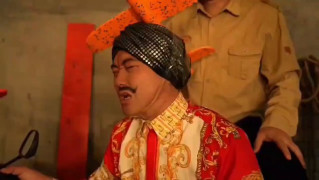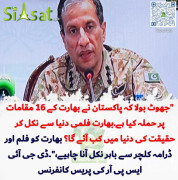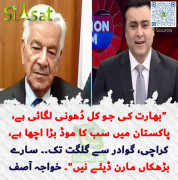canadian
Chief Minister (5k+ posts)
Manufacturing Consent in India
By Riaz Haq
CA
A recent Pew Global Attitudes survey shows that 85% of Indians are satisfied with their government's performance, particularly its handling of the economy. Only the Chinese and Brazilians are more satisfied with their economic situation among the 22 countries included in the survey.
India is a nation which has the dubious distinction of being home to the world's largest population of poor, hungry, illiterate and sick people where 7000 people die of hunger every day. 81% Indians say terrorism is the biggest problem India faces today.
The only way to explain these strange opinions from the Pew Poll in India is to seriously ponder over the following excerpts from MIT's Linguistics and Communications Professor Noam Chomsky's interview recently published in Outlook India:
Q: You once said, Propaganda is to democracy what violence is to totalitarianism. Do you mean that propaganda enables the elite to dull the will of people, depriving them of the capacity to make political choices?
A. That clearly is its goal, in fact its stated goal. Back in the 1920s, it used to be frankly called propaganda. But the word acquired a bad flavor with Nazism in the 1930s. So now, its not called propaganda any more. But they were right in the 1920s. The huge public relations industry, for example, has its goal to control attitudes and beliefs. Liberal commentators, like Walter Lippmann, said we have to manufacture consent and keep the rabble away from the decision-making. We are the responsible men, we have to make decisions and we have to be protected and I quote Lippmann - from the trampling under the rage of the bewildered herd the public. In the democratic process, we are the participants, they watch. And the task of intellectuals, media and so on is to make sure that they are quiet, subdued and obedient. That is the view from the liberal end of the spectrum. Yes, I dont doubt that the media is liberal in that sense.
Professor Noam Chomsky, co-author with Ed Herman of Manufacturing Consent, also told Outlook India that media subdues the public. Its so in India, certainly".
Here are some more excerpts from Chomsky's Outlook interview:
"I spent three weeks in India and a week in Pakistan. A friend of mine here, Iqbal Ahmed, told me that I would be surprised to find that the media in Pakistan is more open, free and vibrant than that in India.
In Pakistan, I read the English language media which go to a tiny part of the population. Apparently, the government, no matter how repressive it is, is willing to say to them that you have your fun, we are not going to bother you. So they dont interfere with it.
The media in India is free, the government doesnt have the power to control it. But what I saw was that it was pretty restricted, very narrow and provincial and not very informative, leaving out lots of things. What I saw was a small sample. There are very good things in the Indian media, specially the Hindu and a couple of others. But this picture (in India) doesnt surprise me. In fact, the media situation is not very different in many other countries. The Mexican situation is unusual. La Jornada is the only independent newspaper in the whole hemisphere.
"As soon as the plan to invade Iraq was announced, the media began serving as a propaganda agency for the government. The same was true for Vietnam, for state violence generally. The media is called liberal because it is liberal in the sense that Obama is. For example, hes considered as the principled critic of the Iraq war. Why? Because, right at the beginning, he said it was a strategic blunder. Thats the extent of his liberalism. You could read such comments in Pravda in 1985. The people said that the invasion of Afghanistan was a strategic blunder. Even the German general staff said that Stalingrad was a strategic blunder. But we dont call that principled criticism."
"Perhaps the period of greatest real press freedom was in the more free societies of Britain and the US in the late 19th century. There was a great variety of newspapers, most often run by the factory workers, ethnic communities and others. There was a lot of popular involvement. These papers reflected a wide variety of opinions, were widely read too. It was the period of greatest vibrancy in the US. There were efforts, especially in England, to control and censor it. These didnt work. But two things pretty much eliminated them. One, it was possible for the corporate sector to simply put so much capital into their own newspapers that others couldnt compete. The other factor was advertising; advertiser-reliance. Advertisers are businesses. When newspapers become dependent on advertisers for their income, they are naturally going to bend to the interest of advertisers.
If you look at the New York Times, maybe the worlds greatest newspaper, they have the concept of news hole. What that means is that in the afternoon when they plan for the following days newspaper, the first thing they do is to layout where the advertising is going to be, because thats an important part of a newspaper. You then put the news in the gaps between advertisements. In television there is a concept called content and fill. The content is the advertising, the fill is car chase, the sexy or whatever you put in to try to keep the viewer watching in between the ads. Thats a natural outcome when you have advertiser-reliance."
Chomsky is not alone in his assessment of the Indian media. Here are a few other examples:
1. Alice Albinia in the preface to her book "Empires of the Indus":
"It was April, 2000, almost a year since the war between Pakistan and India over Kargil in Kashmir had ended, and the newspapers which the delivery man threw on to my terrace every morning still portrayed Pakistan as a rogue state, governed by military cowboys, inhabited by murderous fundamentalists: the rhetoric had the patina of hysteria."
2. John Briscoe, Harvard Professor and water expert on coverage of India-Pakistan water dispute:
Living in Delhi and working in both India and Pakistan, I was struck by a paradox. One country was a vigorous democracy, the other a military regime. But whereas an important part of the Pakistani press regularly reported India's views on the water issue in an objective way, the Indian press never did the same. I never saw a report which gave Indian readers a factual description of the enormous vulnerability of Pakistan, of the way in which India had socked it to Pakistan when filling Baglihar. How could this be, I asked? Because, a journalist colleague in Delhi told me, "When it comes to Kashmir and the Indus Treaty is considered an integral part of Kashmir -- the ministry of external affairs instructs newspapers on what they can and cannot say, and often tells them explicitly what it is they are to say."
3. Shekhar Gupta in Indian Express:
Can we deny the fact that every new terror attack on the Pakistani establishment, every development that marks a further decline in the authority of its government is greeted with an utterly unconcealed sense of delight? This is not just the mood of the mobs here. Even the intelligentsia, the TV talking heads, opinion page columnists, government spokespersons, all have the same smug air of I-told-you-so and so-what-else-did-they-expect satisfaction. And they ask the same patronizing question: hell, can Pakistan be saved?
It is time therefore to stop jubilating at the unfolding tragedy in Pakistan. India has to think of becoming a part of the solution. And that solution lies in not merely saving Pakistan Pakistan will survive. It has evolved a strong nationalism that does bind its people even if that does not reflect in its current internal dissensions. It is slowly building a democratic system, howsoever imperfect. But it has a very robust media and a functional higher judiciary. Also, in its army, it has at least one national institution that provides stability and continuity. The question for us is, what kind of Pakistan do we want to see emerging from this bloodshed? What if fundamentalists of some kind, either religious or military or a combination of both, were to take control of Islamabad? The Americans will always have the option of cutting their losses and leaving. They have a long history of doing that successfully, from Vietnam to Iraq and maybe Afghanistan next. What will be our Plan-B then?
(www.pakistanlink.com)
By Riaz Haq
CA
A recent Pew Global Attitudes survey shows that 85% of Indians are satisfied with their government's performance, particularly its handling of the economy. Only the Chinese and Brazilians are more satisfied with their economic situation among the 22 countries included in the survey.
India is a nation which has the dubious distinction of being home to the world's largest population of poor, hungry, illiterate and sick people where 7000 people die of hunger every day. 81% Indians say terrorism is the biggest problem India faces today.
The only way to explain these strange opinions from the Pew Poll in India is to seriously ponder over the following excerpts from MIT's Linguistics and Communications Professor Noam Chomsky's interview recently published in Outlook India:
Q: You once said, Propaganda is to democracy what violence is to totalitarianism. Do you mean that propaganda enables the elite to dull the will of people, depriving them of the capacity to make political choices?
A. That clearly is its goal, in fact its stated goal. Back in the 1920s, it used to be frankly called propaganda. But the word acquired a bad flavor with Nazism in the 1930s. So now, its not called propaganda any more. But they were right in the 1920s. The huge public relations industry, for example, has its goal to control attitudes and beliefs. Liberal commentators, like Walter Lippmann, said we have to manufacture consent and keep the rabble away from the decision-making. We are the responsible men, we have to make decisions and we have to be protected and I quote Lippmann - from the trampling under the rage of the bewildered herd the public. In the democratic process, we are the participants, they watch. And the task of intellectuals, media and so on is to make sure that they are quiet, subdued and obedient. That is the view from the liberal end of the spectrum. Yes, I dont doubt that the media is liberal in that sense.
Professor Noam Chomsky, co-author with Ed Herman of Manufacturing Consent, also told Outlook India that media subdues the public. Its so in India, certainly".
Here are some more excerpts from Chomsky's Outlook interview:
"I spent three weeks in India and a week in Pakistan. A friend of mine here, Iqbal Ahmed, told me that I would be surprised to find that the media in Pakistan is more open, free and vibrant than that in India.
In Pakistan, I read the English language media which go to a tiny part of the population. Apparently, the government, no matter how repressive it is, is willing to say to them that you have your fun, we are not going to bother you. So they dont interfere with it.
The media in India is free, the government doesnt have the power to control it. But what I saw was that it was pretty restricted, very narrow and provincial and not very informative, leaving out lots of things. What I saw was a small sample. There are very good things in the Indian media, specially the Hindu and a couple of others. But this picture (in India) doesnt surprise me. In fact, the media situation is not very different in many other countries. The Mexican situation is unusual. La Jornada is the only independent newspaper in the whole hemisphere.
"As soon as the plan to invade Iraq was announced, the media began serving as a propaganda agency for the government. The same was true for Vietnam, for state violence generally. The media is called liberal because it is liberal in the sense that Obama is. For example, hes considered as the principled critic of the Iraq war. Why? Because, right at the beginning, he said it was a strategic blunder. Thats the extent of his liberalism. You could read such comments in Pravda in 1985. The people said that the invasion of Afghanistan was a strategic blunder. Even the German general staff said that Stalingrad was a strategic blunder. But we dont call that principled criticism."
"Perhaps the period of greatest real press freedom was in the more free societies of Britain and the US in the late 19th century. There was a great variety of newspapers, most often run by the factory workers, ethnic communities and others. There was a lot of popular involvement. These papers reflected a wide variety of opinions, were widely read too. It was the period of greatest vibrancy in the US. There were efforts, especially in England, to control and censor it. These didnt work. But two things pretty much eliminated them. One, it was possible for the corporate sector to simply put so much capital into their own newspapers that others couldnt compete. The other factor was advertising; advertiser-reliance. Advertisers are businesses. When newspapers become dependent on advertisers for their income, they are naturally going to bend to the interest of advertisers.
If you look at the New York Times, maybe the worlds greatest newspaper, they have the concept of news hole. What that means is that in the afternoon when they plan for the following days newspaper, the first thing they do is to layout where the advertising is going to be, because thats an important part of a newspaper. You then put the news in the gaps between advertisements. In television there is a concept called content and fill. The content is the advertising, the fill is car chase, the sexy or whatever you put in to try to keep the viewer watching in between the ads. Thats a natural outcome when you have advertiser-reliance."
Chomsky is not alone in his assessment of the Indian media. Here are a few other examples:
1. Alice Albinia in the preface to her book "Empires of the Indus":
"It was April, 2000, almost a year since the war between Pakistan and India over Kargil in Kashmir had ended, and the newspapers which the delivery man threw on to my terrace every morning still portrayed Pakistan as a rogue state, governed by military cowboys, inhabited by murderous fundamentalists: the rhetoric had the patina of hysteria."
2. John Briscoe, Harvard Professor and water expert on coverage of India-Pakistan water dispute:
Living in Delhi and working in both India and Pakistan, I was struck by a paradox. One country was a vigorous democracy, the other a military regime. But whereas an important part of the Pakistani press regularly reported India's views on the water issue in an objective way, the Indian press never did the same. I never saw a report which gave Indian readers a factual description of the enormous vulnerability of Pakistan, of the way in which India had socked it to Pakistan when filling Baglihar. How could this be, I asked? Because, a journalist colleague in Delhi told me, "When it comes to Kashmir and the Indus Treaty is considered an integral part of Kashmir -- the ministry of external affairs instructs newspapers on what they can and cannot say, and often tells them explicitly what it is they are to say."
3. Shekhar Gupta in Indian Express:
Can we deny the fact that every new terror attack on the Pakistani establishment, every development that marks a further decline in the authority of its government is greeted with an utterly unconcealed sense of delight? This is not just the mood of the mobs here. Even the intelligentsia, the TV talking heads, opinion page columnists, government spokespersons, all have the same smug air of I-told-you-so and so-what-else-did-they-expect satisfaction. And they ask the same patronizing question: hell, can Pakistan be saved?
It is time therefore to stop jubilating at the unfolding tragedy in Pakistan. India has to think of becoming a part of the solution. And that solution lies in not merely saving Pakistan Pakistan will survive. It has evolved a strong nationalism that does bind its people even if that does not reflect in its current internal dissensions. It is slowly building a democratic system, howsoever imperfect. But it has a very robust media and a functional higher judiciary. Also, in its army, it has at least one national institution that provides stability and continuity. The question for us is, what kind of Pakistan do we want to see emerging from this bloodshed? What if fundamentalists of some kind, either religious or military or a combination of both, were to take control of Islamabad? The Americans will always have the option of cutting their losses and leaving. They have a long history of doing that successfully, from Vietnam to Iraq and maybe Afghanistan next. What will be our Plan-B then?
(www.pakistanlink.com)































